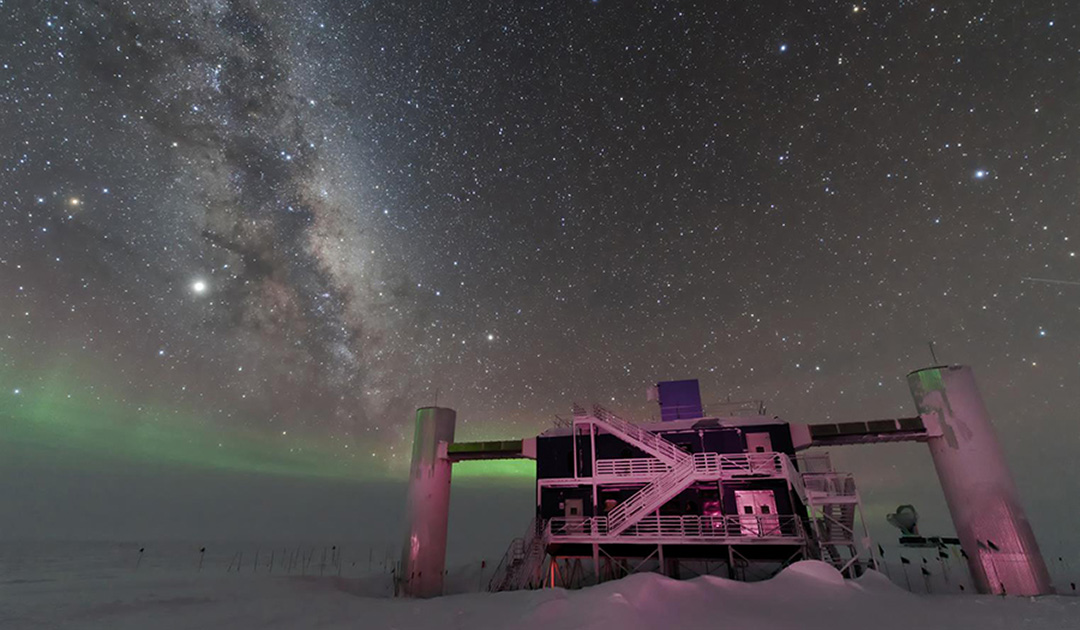
The IceCube Neutrino Observatory at the South Pole has been capturing neutrinos from various sources for nearly 11 years. After the observatory recently enabled scientists to identify various cosmic structures that produce neutrinos, an international research team has now succeeded for the first time in estimating the probability of a neutrino originating from a particular source. The study was published in The Astrophysical Journal.
The tiny, nearly massless elementary particles travel through the universe at nearly the speed of light and were probably first created during the Big Bang. Today, neutrinos are produced by fusion reactions inside stars (including our Sun), by supernova explosions when massive stars die, and by violent transformations of matter and energy in the vicinity of black holes.
Since its launch in May 2011, IceCube has detected more than a hundred cosmic neutrinos, and scientists have even been able to determine the origin of some: blazars, a nearby Seyfert galaxy, and a tidal disruption event. The latter occurs when a star gets too close to a supermassive black hole and is engulfed by it.

However, the cosmic neutrinos do not come from the different sources in equal proportions. The proportions depend on how many of these structures there are in the known universe, how often they can create a neutrino, and how likely it is that this neutrino will reach Earth.
The researchers found that blazars account for only 6% the total neutrino flux. This makes it all the more surprising to Imre Bartos, a physicist at the University of Florida and lead author of the study, that IceCube has already detected a neutrino with this origin.
“It was surprising to some at least that the first detection of a neutrino from an astrophysical source that we see was actually a blazar,” Bartos said. As Bartos further explains, blazars are very rare compared to other galactic nuclei. Therefore, they are easy for astronomers to identify, which in turn makes it easier to associate them with a neutrino.
Stellar tidal disruption events account for nearly one-third of the total cosmic neutrino flux, although they are also rare and provide black holes with little matter compared to the amount of gas and dust they continuously consume as active galactic nuclei, which is also surprising to Bartos.

The largest fraction of neutrinos, 36%, comes from active galactic nuclei, supermassive black holes that include Seyfert galaxies and quasars. Other, unknown sources also account for nearly 30% of cosmic neutrinos. “We can see this indication of an extra source type or multiple source types that are not within these three,” Bartos says. “So that was the other major surprise we found in the pie chart.”
Researchers are now wondering if these unknown neutrino sources are associated with supermassive black holes, as is the case with active galactic nuclei, blazars and tidal disruption events. Could the neutrinos come from smaller black holes, supernovae or other unsuspected cosmic objects?
“We have now at least four source types, which means that we have a very good chance of learning much more about the Universe by looking at them and studying these more,” Bartos says. “So this is really, really exciting.”
And the more neutrino sources the observatory can identify, the more scientists can learn about the cosmos and the chaotic environments that produce neutrinos.
“The key goal is to use these sources to dig deeper and understand what is actually accelerating these particles to the highest energies a billion times higher than what we can do here on Earth,” Bartos says.
Julia Hager, PolarJournal / Original text: Lauren Lipuma, Antarctic Sun
Link to IceCube website: https://icecube.wisc.edu
More about this topic





